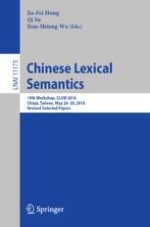2018 | OriginalPaper | Buchkapitel
Somewhere in COLDNESS Lies Nibbāna: Lexical Manifestations of COLDNESS
verfasst von : Jiajuan Xiong, Chu-Ren Huang
Erschienen in: Chinese Lexical Semantics
Aktivieren Sie unsere intelligente Suche, um passende Fachinhalte oder Patente zu finden.
Wählen Sie Textabschnitte aus um mit Künstlicher Intelligenz passenden Patente zu finden. powered by
Markieren Sie Textabschnitte, um KI-gestützt weitere passende Inhalte zu finden. powered by
Abstract
 han2 ‘cold’,
han2 ‘cold’,
 leng3 ‘cold’ and
leng3 ‘cold’ and
 liang2 ‘cool’, in their synaesthetic and metaphorical uses in Modern Chinese. It is found that
liang2 ‘cool’, in their synaesthetic and metaphorical uses in Modern Chinese. It is found that
 leng3 ‘cold’ is most versatile whereas
leng3 ‘cold’ is most versatile whereas
 liang2 ‘cool’ is most inert with regard to their synaesthetic and metaphorical mappings, with
liang2 ‘cool’ is most inert with regard to their synaesthetic and metaphorical mappings, with
 han2 ‘cold’ standing in the middle. Moreover,
han2 ‘cold’ standing in the middle. Moreover,
 han2 ‘cold’ tends to be object-oriented, while
han2 ‘cold’ tends to be object-oriented, while
 liang2 ‘cool’ is likely to be subject-oriented, with
liang2 ‘cool’ is likely to be subject-oriented, with
 leng3 ‘cold’ allowing both subject- and object-oriented readings. We further conduct a study on the uses of these three tactile words in Buddhist texts of Āgamas, finding that
leng3 ‘cold’ allowing both subject- and object-oriented readings. We further conduct a study on the uses of these three tactile words in Buddhist texts of Āgamas, finding that
 liang2 ‘cool’ was consistently employed to refer the nibbānic status. Apart from it, two counts of
liang2 ‘cool’ was consistently employed to refer the nibbānic status. Apart from it, two counts of
 leng3 ‘cold’ exhibit the nibbānic meaning. However,
leng3 ‘cold’ exhibit the nibbānic meaning. However,
 han2 ‘cold’ is never attested in this philosophical meaning. It is interesting to note that a kind of tactile feeling is associated with nibbāna, even though nibbānic experience is supposed to transcend sensory experience. This finding, together with some other findings with regard to the relation between sensory expressions and nibbāna, can shed light on the linguistc expressions of the inexpressible nibbāna.
han2 ‘cold’ is never attested in this philosophical meaning. It is interesting to note that a kind of tactile feeling is associated with nibbāna, even though nibbānic experience is supposed to transcend sensory experience. This finding, together with some other findings with regard to the relation between sensory expressions and nibbāna, can shed light on the linguistc expressions of the inexpressible nibbāna.
 . The near synonym pair Sheng and Yin: A study of the relation between sense and concept
. The near synonym pair Sheng and Yin: A study of the relation between sense and concept  . Paper presented at the Chinese lexical semantic workshop: current and trends in chinese lexical semantic research
. Paper presented at the Chinese lexical semantic workshop: current and trends in chinese lexical semantic research  . Peking University, Beijing (2004)
. Peking University, Beijing (2004)
 . The near synonym pair Sheng and Yin: a study of the relation between sense and cognitive concept
. The near synonym pair Sheng and Yin: a study of the relation between sense and cognitive concept  . In:
. In: 
 (2018)
(2018)
 . Synaesthesia: Language, thought, cognition and culture
. Synaesthesia: Language, thought, cognition and culture  . IEICE Technical report
. IEICE Technical report  , vol. 116, no. 368 pp. 111–113 (2016)
, vol. 116, no. 368 pp. 111–113 (2016)



 Linguistic Synaesthesia, Metaphor and Cognition: the systematicity and significance of linguistic synaesthesia in Chinese. To Appear in
Linguistic Synaesthesia, Metaphor and Cognition: the systematicity and significance of linguistic synaesthesia in Chinese. To Appear in  (to appear)
(to appear)

 A Study on the Mapping Model and Underlying Mechanisms of Synaesthetic Metaphors in Mandarin.
A Study on the Mapping Model and Underlying Mechanisms of Synaesthetic Metaphors in Mandarin.  Language Teaching and Linguistic Studies. 01(no. 189), pp. 44–55 (2018)
Language Teaching and Linguistic Studies. 01(no. 189), pp. 44–55 (2018)